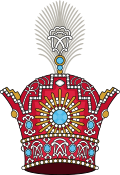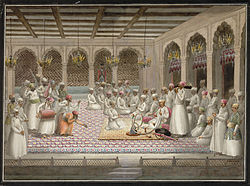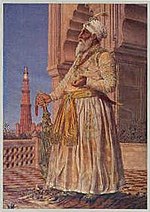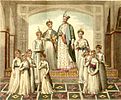Nawab
This article includes a list of general references, but it lacks sufficient corresponding inline citations. (September 2010) |
| Part of a series on |
| Imperial, royal, noble, gentry and chivalric ranks in West, Central, South Asia and North Africa |
|---|
 |
|
|
Nawab (
"Nawab" usually refers to males and literally means Viceroy; the female equivalent is "Begum" or "Nawab Begum". The primary duty of a Nawab was to uphold the sovereignty of the Mughal emperor along with the administration of a certain province.
The title of "nawabi" was also awarded as a personal distinction by the paramount power, similar to a
The term "
History

Nawab was a

The term nawaab is often used to refer to any Muslim ruler in north or
Under later British rule, nawabs continued to rule various
Some princes became nawab by promotion. For example, the ruler of Palanpur was "diwan" until 1910, then "nawab sahib". Other nawabs were promoted are restyled to another princely style, or to and back, such as in Rajgarh a single rawat (rajah) went by nawab.
The style for a nawab's wife is
Before the incorporation of the
Ruling nawab families

Nawabi dynasties acceding to India
- Nawab of Akbarpur - Asmatara Farida Begum
- Nawab Mir Osman Ali Khan Bahadur, the 7th Nizam of Hyderabad
- Nawab of Ashwath
- Nawab Babi of Balasinor
- Masulipatam
- Nawab of Baoni
- Nawab of Basai, Nawab Khwaja Muhammad Khan
- Nawab of Berar styled Mirza of Berar (title held by the heir to the Nizam of Hyderabad)
- Nawab of Bhikampur and Datawali
- Nawab of Bhopal(female rulers were known as Nawab Begum)
- Nawabs of Cambay
- the former Nawabs of the Carnatic, restyled Princes of Arcot
- Nawab of Dujana
- Nawab of Farrukhabad
- Nawab of Jaora
- Nawab Sahib of Junagadh
- Nawab of Malerkotla
- Nawab of Muhammadgarh
- Nawab Sahib of Palanpur (Diwan until 1910)
- Nawab of Awadh
- Nawab of Pathari
- Nawab of Radhanpur
- Nawab of Rampur
- Nawab of Sachin
- Nawab of Sardhana
- Nawab of Tonk, India
- Nawab of Ghazipur
Nawabi dynasties in India abolished before independence
- Nawab of Kurwai
- Nawab of Pataudi
- Nawab of Savanur
- Nawab of Mamdot
- Nawab of Tarakote State
- Nawab of Farukhnagar
- Nawab of Jhajjar
- Nawab of Surat
- Nawab of Mohna
Nawabi dynasties acceding to Pakistan
Nawabi dynasties acceding to Bangladesh
- Nawab of Bengal
- Nawab of Dhaka
- Nawab of Longla(Sylhet)
Former dynasties which became political pensioners
- Padshah-i-Oudh, formerly Nawab Wazirof Awadh,
- also imperial Wazir of all Mughal India, both hereditary
- Nawabs of Bengal, as Nawabs of Murshidabad
- Nawab of Marauli
- Nawab of Patna
- Nawab of Surat
- Nawab of Longla(Sylhet)
Rohilla Confederation[2]
All of these states were at some point under the authority of the Nawab of Rohilkhand, later made the Nawab of Rampur. Most of these states were annexed at the close of the First Rohilla War.
- Nawab of Badaun
- Nawab of Moradabad
- Nawab of Bareilly
- Nawab of Najibabad
- Nawab of Philibit
- Nawab of Farrukhabad
- Nawab of Bisollee
Miscellaneous nawabs
Personal nawabs
The title nawab was also awarded as a personal distinction by the paramount power, similarly to a
Nawab as a court rank

Nawab was also the rank title—again not an office—of a much lower class of
Related titles
Nawabzada
This style, adding the Persian suffix -zada which means son (or other male descendants; see other cases in prince), etymologically fits a nawab’s sons, but in actual practice various dynasties established other customs.
For example, in
Elsewhere, there were rulers who were not styled nawbab yet awarded a title nawabzada to others.
Naib (Ottoman, Iranian, Arabic title)
The word naib (
Today, the word is used to refer to directly elected legislators in lower houses of parliament in many Arabic-speaking areas to contrast them against officers of upper houses (or
"Naib" has also been used in the
"Nabob", derived colloquial term
In colloquial usage in English (since 1612),[4] adopted in other Western languages, the transliteration "nabob" refers to commoners: a merchant-leader of high social status and wealth. "Nabob" derives from the Bengali pronunciation of "nawab": Bengali: নবাব nôbab.
During the 18th century in particular, it was widely used as a disparaging term for British merchants or administrators who, having made a fortune in India, returned to Britain and aspired to be recognised as having the higher social status that their new wealth would enable them to maintain. Jos Sedley in Thackeray's Vanity Fair is probably the best known example in fiction.
From this specific usage it came to be sometimes used for ostentatiously rich businesspeople in general.
"Nabob" can also be used metaphorically for people who have a grandiose sense of their own importance, as in the famous alliterative dismissal of the news media as "nattering nabobs of negativism" in a speech that was delivered by Nixon's vice president Spiro Agnew and written by William Safire.[5]
Gallery
- Some Nawabs of India
-
Hyder Beg Khan of Awadh
-
Nawabs hunting a blackbuck with their Asiatic cheetah
-
Nawabs and cheetahs
-
Nawab of Kalabaghand chief of the Awan tribe
-
Afsharids and a Mughalnawab
-
Nawab of Carnatic
-
Shuja-ud-Daula and his sons and relative
-
Nawabs in battle during theBattle of Panipat (1761)
-
Nawab of the Carnaticin battle
-
A nawab, during the reign of theMughal Emperor Shah Jahan
-
Nawab of Bengal
-
Nawab of the Carnatic
-
Nawab of Bengal
Indian states formerly ruled by Nawabs
- Amb (Tanoli)
- Arcot
- Awadh
- Bahawalpur
- Balasinor
- Banganapalle
- Baoni
- Bengal
- Berar (nominally under Nizam of Hyderabad)
- Bhopal
- Cambay
- Dir
- Farrukhabad (Uttar Pradesh, India)
- Farrukhnagar
- Hyderabad
- Jaora
- Junagadh
- Ghazipur
- Tarakote State
- Kurwai
- Kalabagh
- Malerkotla
- Mamdot
- Manavadar
- Warcha
- Palanpur (Gujarat, India)
- Pataudi
- Radhanpur
- Rampur
- Sachin
- Tonk
See also
References
- ^ Sir Robert, Lethbridge (1893). The Golden Handbook of India. p. x.
- ^ Hamilton, Charles. An Historical Relation of the origin, progress and final dissolution of the Rohilla Afghans in the northern provinces of Hindostan. pp. 90–92.
- ^ "vice - Kamus Bahasa Inggeris". Pusat Rujukan Persuratan Melayu. Dewan Bahasa dan Pustaka. Archived from the original on 25 October 2021. Retrieved 25 May 2020.
- ^ Origin of NABOB Archived 3 December 2016 at the Wayback Machine, Merriam-Webster.com. Retrieved 16 September 2010.
- ^ "nattering nabobs of negativism" Archived 10 February 2017 at the Wayback Machine, PoliticalDictionary.com. Retrieved 7 April 2015.
Further reading
- Akbar, M Ali (2012). "Dhaka Nawab Estate". In Islam, Sirajul; Jamal, Ahmed A. (eds.). Banglapedia: National Encyclopedia of Bangladesh (Second ed.). Asiatic Society of Bangladesh.
- Islam, Sirajul (2012). "Nawab". In Islam, Sirajul; Jamal, Ahmed A. (eds.). Banglapedia: National Encyclopedia of Bangladesh (Second ed.). Asiatic Society of Bangladesh.
- Etymology OnLine
- This article incorporates text from a publication now in the public domain: Chisholm, Hugh, ed. (1911). "Nawab". Encyclopædia Britannica. Vol. 19 (11th ed.). Cambridge University Press. p. 317.
















